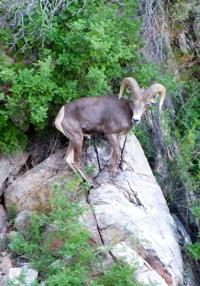No bighorn sheep in the Catalina Mountains are known to have died since May 21 — and state wildlife officials say they expect to declare that a bighorn reintroduction project in the range is a success pending the findings of an October survey of the herd.
“We have 36 collared sheep known to be alive” in the Catalinas north of Tucson, said Mark Hart, a spokesman for the Arizona Game and Fish Department. “There could be as many as 45 uncollared bighorns on the mountain, so the potential total population is 81.”
The total population estimate includes animals that were released without GPS tracking collars, those whose collars have dropped off and those born in the Catalina Mountains.
If the October aerial and ground survey finds 70 or more bighorns, “that would be considered a success,” Hart said. “We believe we can declare the project a success soon, but we need to do that survey. As a scientific agency, we want to use methods that are tried and true.”
POSITIVE SIGNS
“The situation is very stable right now,”Hart said. “We haven’t had a known bighorn mortality in the Catalinas since May 21. We’re pleased. That’s a good outcome.”
He said the animals’ chosen habitat appears to be a key factor in limiting bighorn deaths by mountain lion predation and other causes. Such deaths previously have plagued the project, which began in 2013 in a effort to rebuild a bighorn herd that disappeared from the Catalinas in the 1990s.
“They are tending to stay in the best available habitat, which tends to be the Pusch Ridge habitat” in the southwestern part of the Catalina range,” Hart said. “That’s the single biggest reason that we have had good survival.”
Another positive factor, he said, is that a strain of pneumonia that had killed some bighorns “appears to have run its course.”
“We’re keeping our fingers crossed on that,” he said.
DEFINING SUCCESS
A Tucson attorney who has worked with a group called the Friends of Wild Animals in opposing the reintroduction project questioned the Game and Fish definition of “success.”
“Their definition of ‘success’ for the project has changed, but there isn’t any explanation as to why or what science they used to make a determination of success,” said attorney Cyndi Tuell. “As background, in meeting notes I got from the public records request for January 22, 2013, the (project) advisory committee says that a viable threshold population appears to be 100-plus sheep and that populations below 100 are more susceptible to predation.”
Tuell said notes from a later advisory committee meeting indicated the number of sheep for a successful long-term project was revised down from over 100 to 60 to 80 sheep.
Randy Serraglio of the Center for Biological Diversity, who serves on the citizens’ advisory panel for the project, said he is “very encouraged by the success of the bighorns that have been reintroduced to the Catalinas. It proves that it is good habitat up there and they belong there.” But Serraglio noted the sheep could still face challenges including disease.
CONTINGENCY PLAN
About 90 bighorns from healthy herds elsewhere in the state have been brought to the Catalinas in three transplants, or relocations, since 2013 — and Hart said he wouldn’t rule out another transplant if needed.
If the October survey indicates that the population has declined rather than remaining stable, “there might be another transplant,” he said. “One in November would be a possibility, but it depends on what we find in the survey.”





